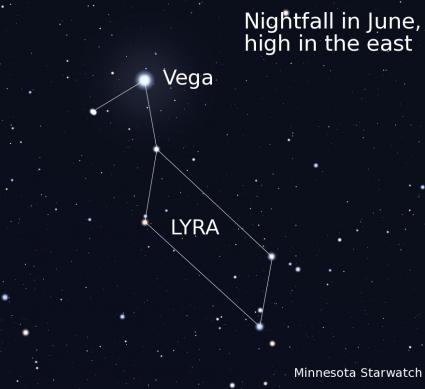Northern Sky: May 25 - June 7, 2019
NORTHERN SKY by Deane Morrison
During the last week of May, the moon wanes away in the morning sky, starting with the last quarter phase on Sunday, the 26th. Last time, I mentioned that the quarter phases are good for moon watching because that’s when lunar features like craters stand out in sharpest relief. So on the 26th, you may want to grab your binoculars again. One small caveat: In Grand Marais, the moon doesn’t rise that day until 2:09 a.m., which may be somewhat inconvenient. On the other hand, if you’re a night owl, the last quarter phase gives you the best chance to explore the part of the moon that isn’t visible at first quarter phase.
If you are up at that hour, you’ll see the Summer Triangle of bright stars above the moon as it rises in the east-southeast, plus Jupiter—the brightest dot—in the south and Saturn to the lower left of Jupiter. But you don’t have to wait till the middle of the night to see those planets. Earth is about to lap them in the race around the sun, and they’re rising earlier every night. We lap Jupiter on June 10, and by the end of the first week in June, Jupiter will up in the southeast by 10 p.m. Saturn follows Jupiter by about two hours. Just west of Jupiter is the red star Antares, the heart of Scorpius.
You might want to try watching Jupiter from night to night. Earth is already starting to lap it, and this makes it moves westward against the backdrop of stars. If you grab those binoculars again, you may detect Jupiter inching westward with respect to several rather dim stars that are near the planet.
And back to the moon for a second. As it wanes, it rises later every morning. If you’re up around 4:30 on June 1 and you have a clear view of the eastern horizon, you may see a very old and thin crescent rising to the lower right of Venus. Moonrise on June 1 is at 4:27 a.m., which is scarcely half an hour before sunrise, so both the moon and Venus will be awash in the sun’s foreglow.
In the evening sky, Spica, the brightest star in Virgo, the maiden, is in the south at nightfall, well below the brilliant star Arcturus. Spica’s not all that bright, but then it’s about 260 light-years away. It’s not a single star, but at least two big ones that orbit each other very closely. Only 11 million miles apart, which is about one-fourth the distance of Mercury from the sun. The strong gravity between these two stars has pulled each of them out into an egg shape, and it’s thought that they spin around like two gigantic eggs with their narrow ends pointed at each other. And they spin really fast: It takes them only four days. This would be incredible to watch if we could get close and look down on these stars.
In the west, Mars is resisting being swallowed by the sun as Earth leaves it behind. Mars is as dim as it gets, but have a look around 40 minutes after sunset on June 4. Mercury will be very low in the west-northwest, a young crescent moon will be just to the left of it, and Mars will be almost directly above the moon. Above Mars, the Gemini twins Pollux, the brighter, and Castor are dropping as they make their seasonal exit from the evening sky. This year they’ll leave in the company of Mars and Mercury.
Deane Morrison writes the Minnesota Starwatch column for the University of Minnesota’s Minnesota Institute for Astrophysics.
Tweet







